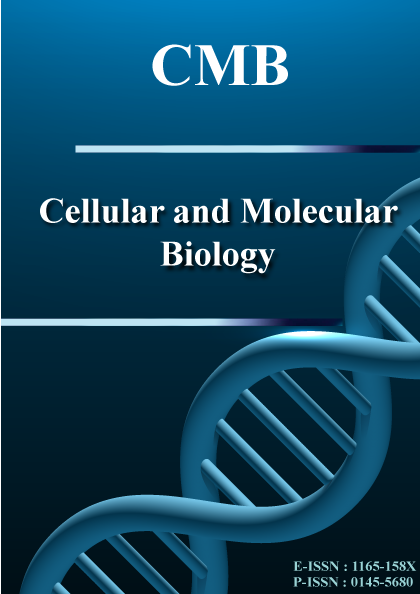Issue
Copyright (c) 2022 Mali Zhuo, Taoqi Zhou, Minming Zhou, Chaochao Tong

This work is licensed under a Creative Commons Attribution-NonCommercial-NoDerivatives 4.0 International License.
The undersigned hereby assign all rights, included but not limited to copyright, for this manuscript to CMB Association upon its submission for consideration to publication on Cellular and Molecular Biology. The rights assigned include, but are not limited to, the sole and exclusive rights to license, sell, subsequently assign, derive, distribute, display and reproduce this manuscript, in whole or in part, in any format, electronic or otherwise, including those in existence at the time this agreement was signed. The authors hereby warrant that they have not granted or assigned, and shall not grant or assign, the aforementioned rights to any other person, firm, organization, or other entity. All rights are automatically restored to authors if this manuscript is not accepted for publication.Cauliflower bioactive compound sulforaphane inhibits breast cancer development by suppressing NF-κB /MMP-9 signaling pathway expression
Corresponding Author(s) : Mali Zhuo
Cellular and Molecular Biology,
Vol. 68 No. 4: Issue 4
Abstract
In recent years, anti-cancer plant food development and research have received increasing attention, and cauliflower is one of the vegetables with anti-cancer effects. Sulforaphane (SFN) is one of the main anti-cancer components in cauliflower. In this study, the mechanism of action of SFN in anti-breast cancer was investigated using SFN, a bioactive compound extracted from cauliflower. For this purpose, SFN was extracted from cauliflower using rotary evaporation and silica gel chromatography, and the extracted SFN was used for in vitro and in vivo experiments. Breast cancer cells MCF-7, MDA-MB-231 and MDA-MB-231 xenograft tumor model mice were treated with SFN, pcDNA3.1-MMP-9, Si-RNA- MMP-9 and Si-RNA-NF-κB, respectively, and the corresponding saline treatment or blank plasmid treatment was used as control. The gene expression of NF-κB and MMP-9 in each group was detected by RT-PCR, and the protein phosphorylation level of MMP-9 was measured by Western bloting assay. WST 1 assay, MTT assay and flow cytometric analysis were used to detect the activity, proliferation and apoptosis levels of breast cancer cells. The tumor histopathology of the xenograft tumor model mice after SFN treatment was examined by HE staining. Results showed that Breast cancer cells treated with SFN showed reduced cell proliferation, decreased cell activity, increased apoptosis ratio, and inhibited gene expression and protein phosphorylation of MMP-9 as well as gene expression of NF-κB (P < 0.05). The same effect occurred with transfection of Si-RNA- MMP-9 and Si-RNA-NF-κB in breast cancer cells, while transfection of pcDNA3.1-MMP-9 plasmid significantly redeemed the inhibitory effect of SFN on breast cancer cells (P < 0.05). MDA-MB-231 xenograft tumor model mice treated with SFN showed significant improvement in the pathological condition of the tumor tissue. Then, SFN may inhibit breast cancer development by regulating the NF-κB /MMP-9 signaling pathway.
Download Citation
Endnote/Zotero/Mendeley (RIS)BibTeX




